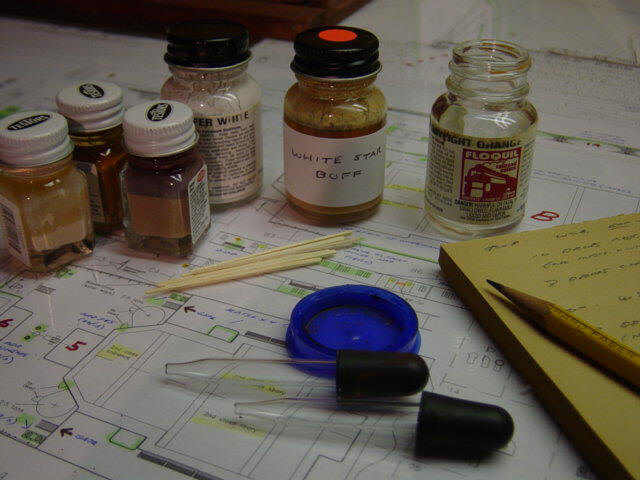

![]()
Mixing your own paint vs using
off-the-shelf colors
by Art Braunschweiger, TRMA
For most modelers, a very realistic effect can be achieved by using stock colors. Thereís no mixing to worry about, and additional quantities are guaranteed by simply purchasing another bottle. In some cases, though, scale effect can be better achieved by mixing, and some color alternatives can only be achieved by mixing. (See the article "Painting Your Model For The Greatest Realism" to read about "scale effect.")
Initial mixing to experiment can be easily done with beverage tops and flat toothpicks. The best caps to use are those that are wide, shallow and smooth on the bottom. But even a piece of plastic will work fine too. Shake each paint bottle thoroughly, and use a small coffee stirrer to check that there is no pigment congealed on the bottom. (This typically happens if a bottle has been sitting on the retailerís shelf for a few months.) Then dip a toothpick into the bottle, and let the paint drip from the toothpick onto the bottlecap. Make sure to count the drops, and write it down. After all your drops are in the cap, take another flat toothpick, partially break the wide tip about 1/8" from the end to a 45 degree angle, and you have a handy stirrer for the paint. You can also use the same stirrer to apply the paint to a scrap of paint. With each test application, number the mix on your notepaper and number the application on the test piece. Thereís nothing more frustrating than achieving the correct color and not knowing which mix it was.
Mixing in this way saves all the work of cleaning eyedroppers each time, and many test mixes can be made in a short amount of time with minimal cleanup. Keep writing down your test mixes, and if mixing to achieve scale effect, keep increasing your "modifying color" by one drop each time. For example, try 8 drops of black and 1 of white, then 9 and 1, 10 and 1, etc.
After you decide on a particular mix, mix up a batch. Most modeling shops sell empty bottles. Label it, then mix your paint using one full eyedropper of paint for each drop in your mix. If you will need a large amount (the hull, for example) just double or triple each number in the mix. Be sure to test the mix again when youíre done! If it still looks good, document the brand, the name and the number, and how many eyedroppers of each.
Most model paints are compatible with one another, providing you're not mixing acrylic (water-based) with solvent-based. Otherwise, most brands are compatible. All the Testors brands for example can be readily mixed together.
Lastly, two very important things to remember: one, watch your light! Colors mixed under fluorescent light will look different than under incandescent light, and sunlight through a window will cause the color to look different yet. Second, all colors will look different after they dry. A test application, dry and viewed under the light conditions where your model will be displayed, is the best way to ensure that youíve chosen the right mix.
![]()
WHERE TITANIC RESEARCH MEETS TITANIC CRAFTSMANSHIP SINCE 1998